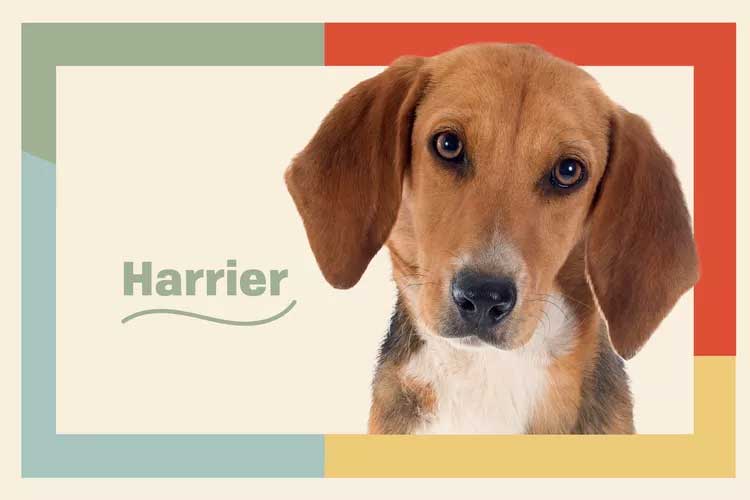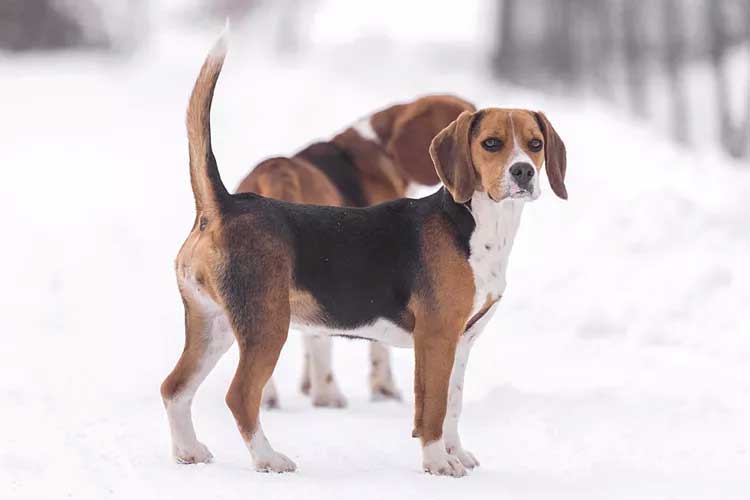Harriers are friendly, high-energy dogs that love spending time with their human and canine family members. Learn more about living with these active hounds.

Harrier Overview
| OFFICIAL NAME | Harrier |
| COMMON NAME | Harrier |
| PET HEIGHT | 19 to 21 inches |
| PET WEIGHT | 45 to 60 pounds |
| LIFESPAN | 12 to 15 years |
| GOOD WITH | children, dogs, families |
| TEMPERAMENT | friendly, outgoing, playful |
| INTELLIGENCE | high |
| SHEDDING AMOUNT | normal |
| EXERCISE NEEDS | high |
| ENERGY LEVEL | active |
| VOCAL LEVEL | howler |
| DROOL AMOUNT | low |
| BREED GROUP | hound |
| BREED SIZE | medium (26-60 lbs.) |
| COAT LENGTH | short |
| COLORS | black, brown / chocolate / liver, gold / yellow, red, white |
| PATTERNS | black and tan, tricolor |
| OTHER TRAITS | easy to groom, good hiking companion, high potential for weight gain, high prey drive, strong loyalty tendencies, tolerates being alone |
Often mistaken for their cousin the beagle, harriers are spunky, social hound dogs who love being around people. Though they make great hiking companions and they're super affectionate with their family members, these medium-sized brown, white, and black dogs are uncommon. Originally developed by British hunters, harriers are intelligent super-sniffers who can run, walk, and play all day long.
"This breed is affectionate, athletic, and intelligent," says Corinne Wigfall, DVM, BVS, BVM, and consulting veterinarian with SpiritDog Training. "They make great companions in families and great sport partners for the active owner."
Appearance
What is a harrier, exactly? The running joke among hound aficionados is that this breed is like a beagle who started hitting the weight-lifting equipment at the gym."They are sometimes referred to as a beagle on steroids," says Linda Simon, MVB, MRCVS, consulting veterinarian at FiveBarks.

Harriers are larger and more muscular than beagles, standing 19–21 inches tall and weighing 45–60 pounds (beagles, for a helpful comparison, are just 13–15 inches tall and weigh 20–30 pounds). Harriers are also related to the larger English foxhound.
Harriers have a distinctive, hound-like appearance. They're typically black and tan; black, white, and tan; lemon and white; red and white; or white with no markings.
They're sturdy and powerful, and they have a short and glossy coat that's very inviting to pet. Their velvety ears flop down along the sides of their faces and have rounded tips. The breed stands tall and proud with their medium-length tails held high behind them.
Temperament
Like their beagle cousins, harriers are friendly, playful, and always on the move. They're very good with children and they absolutely adore their family members, of both the human and the canine variety.Though they can handle being alone for periods of time, these social pups really thrive when they're around people all day. As such, they may not be the best choice for people with extended workdays, long commutes, or jam-packed social calendars that make them too busy to spend time with their dog. Getting another pup to keep a harrier company can also help.
"They make great companions as pets, so someone who can spend a lot of time with them is important," Wigfall says. "Being a pack dog, they also thrive in a home with another dog as a companion."

Since they were bred to accompany British hunters in their pursuit of foxes and hares, these intelligent dogs have a high prey drive and super-charged noses—and these traits can sometimes get them into trouble. Their instinct to follow a scent wherever it takes them is incredibly strong, so harriers need securely fenced yards and should always be walked on a leash. Some harriers love to dig, too, so it's also a good idea to keep an eye on them when they're outside.
These high-energy dogs will gladly follow you around the house while you do chores or curl up next to you on the couch, so long as they've had enough exercise first.
"This is a working breed, so they have a very strong prey drive and a lot of energy," says Nicole Ellis, CPDT-KA, pet lifestyle expert with Rover.
Living Needs
Like other hound dogs, harriers can be quite chatty. They often "sing" when they're excited and they're quick to alert you if someone is at the door (though don't confuse harriers with watch dogs—they'll almost certainly greet the person with tail-wags and enthusiastic sniffs).As long as your neighbors don't mind hearing your harrier through the walls from time to time, these versatile pups can live in apartments or condos. Ideally, though, they're best suited for homes with room to roam—a large, fenced yard gives harriers lots of opportunities to sniff and run.
But no matter where they live, it's paramount that harriers get daily exercise opportunities like walks, jogs, or extended play sessions with toys or other dogs.
"For most owners, their standout trait is their endless energy reserve," Simon says.
Because of their strong prey drive, harriers are not the best fit for homes with other small mammals for pets, such as rabbits and cats. But these highly adaptable dogs are open to meeting new people, so if you love to throw parties or have people over to your house, your harrier will ensure that everyone feels right at home.

Training a harrier dog is usually a breeze, thanks to this breed's eagerness to please their human companions (though, at times, harriers can have an independent streak!).
It's also a good idea to keep a steady supply of delicious, high-value treats on hand to help reinforce positive behaviors; they also enjoy praise and a good scratch behind the ear, too. These dogs thrive in more structured training environments, including puppy classes (which offer the added benefit of helping your harrier puppy get socialized and meet other dogs and people).
Because they're working dogs who were bred for physically and mentally stimulating situations, harriers have a tendency to become bored. And a bored harrier is an unhappy harrier. Owners can keep them engaged by teaching them new cues and behaviors, providing them with food puzzles and interactive toys, and regularly taking them to new places with lots of sights and sounds. Nose work training can also help harriers put their excellent sniffers to use.
Care
The list of harrier grooming needs is short and sweet. Because their coat is short, dense, and glossy, it basically takes care of itself—a simple brushing once a week is enough to keep a harrier looking dapper. These pups need occasional baths with dog shampoo to help them look and smell their best (particularly if they like to roll around outside!). Harriers shed a moderate amount and they drool very little, so they're not likely to get the house super dirty, either.Pup parents should clean their harrier's ears regularly, using a gentle ear-cleaning solution that's formulated specifically for dogs. They also benefit from regular nail trims with a grinder or a clipper (a groomer can also help with this if you're not comfortable trimming your dog's nails at home).
To promote oral hygiene, it's also a good idea to brush your harrier's teeth regularly (nightly, if you can swing it) and talk to your veterinarian about whether professional deep-cleanings are necessary for your dog. Yummy dental chews can also do double-duty as a treat and a breath freshener.
Health
Healthy harriers can live to be 12–15 years old. They lead such long, joy-filled lives thanks, in large part, to the vigilance of responsible harrier breeders, who screen their dogs for certain genetic conditions that could be harmful to future generations.Breeders typically test for eye diseases and hip dysplasia (which can cause pain and decreased range of motion for the harrier's hip joints). Some harriers may be susceptible to hypothyroidism but, according to the Harrier Club of America (HCA), the condition is still relatively rare.
Because they love their treats, harriers can easily reach an unhealthy weight if they don't get enough exercise or eat too much. Working with your veterinarian to discuss your harrier's food and treat intake, plus his activity level, is the best way to keep weight-related issues at bay. A vet can also help you decide on the right high-quality dog food to feed your harrier, but a good place to start is with a food that matches the dog's life stage: puppy, adult, or senior.
History
The harrier breed has a long history that dates back to the mid-1200s, when they were developed in England for hunting hares. The name "harrier" even stems from this early job. At the time, harriers were much more popular than beagles, according to the HCA.Though their lineage is a little fuzzy, the harrier dog breed likely made its way to the U.S. with British colonizers in the 17th and 18th centuries. The American Kennel Club recognized the hounds in 1885.
Fun Facts
In the harrier vs. beagle debate, there are some key differences between these two hound breeds. For starters, harriers are typically much bigger than beagles. They're also much less common—if you see a brown, black, and white dog with soft, floppy ears out and about, he's more than likely a beagle. Harriers also tend to be slightly less needy than beagles and, as such, they're less prone to separation anxiety, Simon says.The word "harrier" has many different uses. In addition to being the name of the handsome dog breed, it's also used to describe a human runner and a type of hawk.
Because they were developed to travel long distances over sometimes difficult terrain during British hunting excursions, harriers make great hiking or jogging companions. They'll happily go, go, go all day long (and you'll likely get tired before they do!).